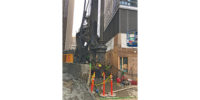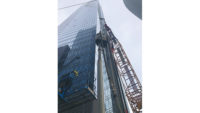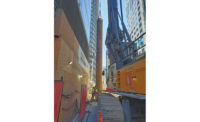A pilot pile program to prove the efficacy of a less-disruptive method for the paused foundation fix at the ailing Millennium Tower in San Francisco could begin the week of Oct. 4. Accelerated settling and tilt—caused by a pile upgrade intended to correct settlement of the 645-ft-tall residential condominium—ceased after Aug. 20, when the engineer-of-record halted the $100-million fix.
“We submitted our pilot program to the city and its review panel and are working to resolve comments,” says Ronald O. Hamburger, senior principal with Simpson Gumpertz & Heger, the fix’s engineer-of-record. “We hope to obtain approval to begin” the pilot work soon, he adds.
Gregory G. Deierlein, chair of the city’s four-person engineering design review team, concurs. “I feel pretty confident our review team will be OK with the revised installation procedure,” he says.
The 58-story tower, which remains occupied, has sunk a total of about 18 in. since its completion in 2008, due to the consolidation of Old Bay Clay, according to Hamburger. The fix itself, likened to putting a bumper jack next to a flat tire, accounts for about 1 in. of the total settlement, he adds.
The upgrade calls for 52 concrete-filled steel-pipe piles within steel casings. By Aug. 20, Shimmick Construction Co. Inc.’s Legacy Foundations had installed thirty-three 36-in.-dia casings and six 24-in.-dia steel-pipe piles. The contractor won’t comment on the fix, says Rusty Lucido, a Legacy vice president.
The pilot program is designed to minimize the amount of soil removed as piles are installed and ensure that sufficient weight of soil and water inside the casings is maintained to prevent heave. It is also aimed at minimizing vibrations induced into the soil.
Settlement, tilt, volume of removed soil, maintenance of pressure within the casing and vibration levels within the sand layer will be monitored. Vibration sensors will be placed in the installed casings.
First, crews would install a permanent 36-in.-dia casing using methods that better control and measure the amount of soil removed and better isolate the casings from vibrations associated with drilling, says Hamburger. If there is minimal settlement, crews would then proceed the following week with the associated 24-in.-dia pile, using a smaller drill bit to minimize excavated material and vibrations. “If significant settlement is still occurring, we will use the vibration recordings to design further mitigations for vibration-induced densification and settlement,” he says.
Potential causes of the fix-related settlement include over-excavation of the soil—resulting in volume loss beneath the existing piles; heave of the underlying Old Bay Clay into the open casings, again causing volume loss; and vibration-induced densification of the sand layer.
In the spring, after installing casings under sidewalks along Fremont Street, crews shifted gears and began casing work under the Mission Street sidewalk, while concurrently installing piles along Fremont. “At this time, about ½ in. of settlement had occurred near the corner of Mission and Fremont,” says Hamburger.
The team voluntarily halted work on the casings along Mission to understand the effect of the pile work on Fremont. After another ½ in. of settlement, “we decided to halt” the entire upgrade, says Hamburger.
The fix relies on jacking the piles, socketed more than 30 ft into bedrock. Piles will support a new mat section, known as a collar, tied to the existing mat. The aim is to transfer some of the building’s weight directly to the deep-seated rock. The team selected a sleeved system to avoid having the new piles transfer the load jacked onto them back into soils that overlay the clay.
As with the pilot pile, crews install the casing that extends 100 ft below grade and tips into Old Bay Clay deposits. Second, crews install the pile that extends into rock, more than 220 ft below grade. The pile consists of a 24-in. pipe, drilled into rock and then withdrawn to the top of the rock. Concrete is placed in the pipe, also filling the hole in the rock made by the casing.
When done, the steel pipe extends down to the rock, but not into it. The concrete fill, with a central steel bar, extends all the way to the bottom of the rock socket—the hole in the rock.
When the upgrade is complete, the casings will isolate the piles from the upper soil deposits so that when the load is transferred off the original foundation onto the new piles, the piles do not reload the consolidating Old Bay Clays. Rather, they are expected to deliver most of the load directly to the rock, says Hamburger.
The fix will not stem tower settlement and tilt in areas away from the new pile system. But because the settling results from secondary compression or creep, it will diminish over time and eventually stabilize, Hamburger predicts. “We project this will allow recovery of most, if not all, of the previous tilting to the north and west.”






Post a comment to this article
Report Abusive Comment